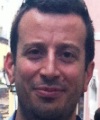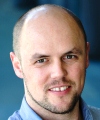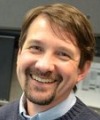Business of Software Delivery Track
 Thomas Murphy Track Chair |
The business of delivering software is increasingly adapting agile techniques driven by a need to deliver compelling user experiences in a world of digital business. This is driving leading IT shops to reconfigure around product teams rather than project teams and is driving tools to support increased collaboration and automation. However, the ability to adopt new practices and tools is a challenge of incorrect expectations and cultural change. This year we will explore how successful teams are connecting business to development and operations to transform from a “what will it cost”, to a “what will it enable” mentality.
We will explore how good AD life-cycle management practices and tools can aid in overcoming challenges such as: global Agile development, driving successful product delivery in regulated environments, and balancing the expectations of management with the reality of application delivery. How can you transition your organization not just to be agile or lean but to be effective, continuously delivering applications that delight customers and adapt to multiple modes of interaction. Some of the focus areas of this track include:
|
Breakout Sessions
 Eray Tuzun Sr. Software Architect Havelsan |
|
Experiences Adopting ALM in a Hybrid Organization
It is a unique challenge to transform to a single ALM platform in a hybrid organization where there is a lot of diversity in platforms (Windows, Linux, MacOsX), programming languages (Java, C, C#, C++ etc.), and development methodologies (various forms of Agile to pure waterfall). In order to support the diverse needs of different projects in the organization, we have heavily customized and extended Microsoft Team Foundation Server especially in requirements management and change management especially for more formal projects in defense and government. By 2015, the majority of the organization is now using the unified ALM toolset and processes. I will discuss the success & failure factors, total economic impact of ALM deployment in the organization, tactics to deploy ALM in a diverse environment, obstacles of ALM adoption in a large scale hybrid organization, and provide the lessons learned. |
|
 Mik Kersten CEO Tasktop |
|
ALM Integration Patterns: From Build Automation to Continuous Collaboration
In this talk, I will review my experiences and lessons learned working with ALM on a very large scale, using examples from the top 10 banks, the largest retailers, and major car manufacturers. Each of these organizations aspired to our collective goal of DevOps transformation, but was challenged by integrating the process of rapid iterations and continuous delivery with existing systems and stakeholders. This led me and my colleagues at these organizations to compile a set of tool-agnostic ALM Integration Patterns, with each pattern--Defect Unification, Agile Orchestration and Supply Chain Integration--building on the core ideas of continuous delivery and release automation. During the session, I will review a case study for each of these patterns and discuss how each implementation lead to ALM success. I will also present a compelling view of a DevOps future that comes directly from my experiences creating the open source Eclipse Mylyn project. On Mylyn we built a fully closed and connected collaboration loop that spanned coding by a handful of developers, to contributions and reviews by hundreds of community members, to continuous deployment and feedback from millions of users. And, we did it in a way that scales to the enterprise. The talk will conclude with an outline of how, using these patterns, you can deploy a real-time build-measure-learn loop that spans your entire software delivery lifecycle. |
|
 Rebecca Parsons CTO ThoughtWorks |
|
Evolutionary Architecture and Micro-Services
|
|
 Kartik Raghavan Sr. VP WW Engineering CollabNet |
|
From an ALM Perspective: 3 Prerequisites Before Jumping on the DevOps Bandwagon
In this session, attendees will be presented the top prerequisites that must be in place to achieve the benefits of ALM, Agile delivery and DevOps on an enterprise scale:
|
|
 Dave West Chief Product Office Tasktop |
|
ALM Industry Panel - chaired by Dave West
Related Resources:Video: ALM Forum 2014 Analyst Panel DZone Interview: Dave West on ALM and Real Software Engineering |
|
 Cheryl Hammond ALM Consultant Northwest Cadence |
|
Effectively Measure Your Teams without Subjugating Them
|
|
 John Wetherill Technology Evangelist ActiveState |
|
Microservices and PaaS
While microservice architectures have been around for a while, they are now gaining serious traction with software organizations, and for good reasons: they enable small targeted teams, rapid continuous deployment, independent updates, true polyglot languages and persistence layers, and a host of other benefits. But truly adopting a microservice architecture requires dramatic changes across the entire organization, and a DevOps culture is absolutely essential. This talk will dive into considerations for implementing microservices architecture, with a focus on the relationships between DevOps, microservices, and PaaS. This session will cover:
This technical session is intended for developers, DevOps, system administrators, and IT decision-makers responsible for building modern cloud applications. |
|
 Jim Szubryt Enterprise Workforce Accenture |
|
Who Does What in DevOps in Large Enterprises
|
|
 Aaron Rudger Director Product Marketing Keynote |
|
Top Tips to Overcome the Language Barrier between the Business and IT Teams
Join this session to hear how to address the top challenges created by continuous delivery that often become barriers to elevating the conversation between IT and digital teams. Aaron Rudger, senior product marketing manager, Keynote will cover:
|
|
 Steve Riley Technical Director Riverbed Technology |
|
Devops and Security: Will they blend?
|
|
 Chris Sterling Sr. Lead Product Manager CenturyLink Cloud |
|
Reduce Time to Value: Focus on Configuration Management Debt First
In organizations that have effective configuration management practices it is common to see deployment pipelines that have a smaller number of hand-offs between teams, architectures that tend to be more malleable, and efficient validation processes. By focusing on reducing Configuration Management Debt it is simpler to identify aspects of the integration and release management process that need to be tackled in order to get working software in the hands of users sooner while reducing the bottlenecks in the organizational processes and practices therefore leading to further optimizations in the future. In this session we will discuss specific approaches and examples on how reducing Configuration Management Debt leads to reducing other forms of software debt including:
|
|
 Bernard Golden VP, Strategy ActiveState |
|
Jumpstarting Your Microservices Future
This presentation will discuss the requirements of a microservices-based application and how IT organizations can most rapidly move to using microservices. Specific topics covered in the presentation include:
|
|
 Jens Donig Senior Consultant HOOD  Martin Kuenzle Program Manager, ALM evosoft |
|
Smart ALM
This talk introduces our Smart ALM approach that domesticates process adaptations and delivers continual improvements as a service. This helped customers in the industry, energy, healthcare, finance, and other sectors to focus on product or solution development, optimize team velocity, and reduce waste. |
|











